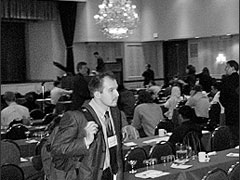Conference Consummation
By Jim Oldfield
Inside the Colony Ballroom of the Chestnut Street Residence at the University of Toronto, the stage was dark and a black Yamaha piano stood at stage right. The audience, settled among rows of red-clothed tables lined with champagne glasses, was silent. This show, however, was not about music; the glasses filled with paper-wrapped candies, not champagne. And the stage was mostly hidden behind a large projection screen lit with the technical language and at times disturbing, yet frequently fascinating, imagery of medical science. The event was the Imaging Network Ontario’s sixth annual Imaging Symposium, held on March 28 and 29.
The symposium brings together scientists funded by the Ontario Research and Development Challenge Fund (ORDCF), from Sunnybrook Research Institute (SRI) and institutions across Ontario, for two days of scientific presentations and discussion with their industry partners.
Industry plays a crucial role in moving basic and applied academic research into the clinic where it can help patients. This, in addition to consolidation and expansion of the imaging industry’s competitive capacity in Ontario, is why the program’s funding, which the province administers—the “daughter” program of which is the Ontario Research Fund-Research Excellence—requires matching investment from industry.
Progress in the realization of these mutually dependent goals was evident in the nature of the talks at this year’s event. In the early years of the symposium, most presentations covered development of basic and specific science ideas. This year, participants engaged in considerable discussion of imaging associated with patients, and of moving imaging toward clinical trials. After the event, Dr. Graham Wright, a senior imaging scientist at SRI and project head for the Ontario Consortium for Cardiac Imaging (OCCI), said, “It does suggest the research is, after six years of this activity, really getting to a stage where we are moving basic ideas toward clinical application. In that sense, it’s very encouraging to see we’ve come so far in that time.”
Wright was also encouraged by the symposium’s poster competition, which he noted serves as a focal point for discussion among scientists and postdoctoral fellows, while providing students with an opportunity to present and defend their work in an intellectually challenging venue. Dr. Charles Cunningham, a scientist in imaging research at SRI and a judge for the competition, said, “[It’s] definitely good experience for the students, and I was really impressed with the calibre of posters—it was at the level of an international conference.”
Sunnybrook accounted for almost one-third of the roughly 300 attendees at the symposium, the largest cohort from a single institute. Members of SRI were well represented in all ORDCF consortia present at the event: the Behavioral Research and Imaging Network, the Ontario Consortium for Image Guided Therapy and Surgery, the Ontario Consortium for Small Animal Imaging and the OCCI, the last two of which SRI scientists lead.
The evolving maturity of the research done within these consortia was a theme resonated by Dr. Peter Liu, scientific director of the Canadian Institutes of Health Research’s Institute of Circulatory and Respiratory Health, in his keynote address. Liu highlighted the role that imaging is now playing within the whole spectrum of understanding disease, detailing the links between systems biology and molecular imaging, and he summarized the importance of imaging and the increasing recognition it is gathering.
Although only the Ontario Consortium for Small Animal Imaging has remaining ORDCF funding for next year, Wright and the other project leaders are seeking new provincial and federal funding for the symposium, and Liu expressed a keen desire to see the venue continue, offering to advocate on behalf of interested consortia members. Despite the event’s uncertain future, Wright feels strongly that its utility and promise are undiminished: “It’s a very stimulating environment where I learn a great deal from colleagues who often work close by, opening new opportunities for collaboration. It’s particularly exciting to now see the clinical translation of basic ideas originally introduced at this symposium just a few years ago.”
Jim Oldfield is the communications coordinator for Sunnybrook Research Institute’s special projects office.
PDF / View full media release »


